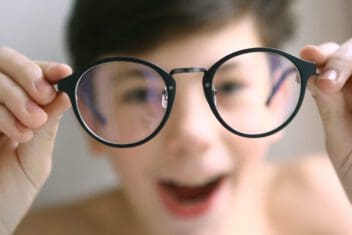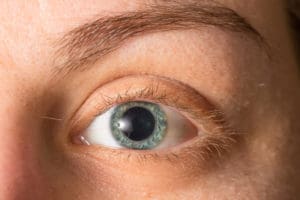Further Reading
How to Find Your Pupillary Distance Before Buying Glasses
Home / Everything About Glasses /
Last Updated:
As the name implies, pupillary distance is a measurement of the space between the centers of your eyes. It’s crucial, as it helps professionals ensure that your glasses refract light properly and amend your troublesome vision.
Table of Contents
During an optical exam, doctors take many pupil measurements. They do not, however, always measure your pupillary distance. You might have to pay more for this small test, and you might have to go to an optician (not an ophthalmologist) to get the results.
Some people believe doctors will not give you the measurement to save money. That is just not true. The measurement isn’t considered to be clinically significant.
If you do not want to sit for a second fitting exam, you can attempt to grab the data on your own at home. But it’s difficult to get the measurement just right.
What Is Pupillary Distance?

If you are asked, you can probably cite your height, weight, shoe size, and waist measurement. But you may not know how far apart your pupils are from one another.
Your pupillary distance (PD) is a measurement between the center of one pupil and the center of the other. It’s a small number, but it’s a critical one for people who wear glasses.
You deserve clear vision. We can help.
With 135+ locations and over 2.5 million procedures performed, our board-certified eye surgeons deliver results you can trust. Your journey to better vision starts here.
As you probably know, your glasses contain two lenses held together by a stiff frame that sits on your nose. Your PD helps the lens-crafting company to cut the lenses just right, so they sit within the frames properly.
As the National Eye Institute explains, glasses work by bending the light that enters your eye. There are multiple types of glasses, including:
- Reading glasses. These lenses help people with aging eyes to see items clearly, even when they are held close to the face.
- Single-vision prescription glasses. The lenses in these items help to correct nearsightedness or farsightedness.
- Multifocal prescription glasses. The lenses in these products can correct both nearsightedness and farsightedness.
Glasses are precise tools, and prescription versions rely on delicate measurements. If something is not quite right, the light will not move as it should. That can lead to:
- Blurred vision.
- Double vision.
- Headaches.
- Nausea.
You may not notice the problem right away. But as you continue to wear ill-fitting glasses, the issue may become painfully obvious. Your eyes are not harmed by lenses that do not fit your eyes. But if you can’t see without discomfort, it’s hard to handle everyday tasks.
Measuring Your Pupillary Distance

During an optometric exam, you will undergo many measurements. Some of them involve your pupils. But not all eye doctors will measure your pupillary distance during an exam.
Many pupil measurements are critical to eye health. The American Academy of Ophthalmology explains that your doctor will:
- Examine your pupils in a bright room. Your doctor will measure how big your pupils are both in natural light and when a light is shined into your eyes. Your doctor will ensure that your eyes constrict and that both eyes work in the same way.
- Examine your pupils in a dark room. Your doctor will look at your eyes while you are sitting in low light. Your doctor may measure how big your pupils are and compare those readings to anatomical charts.
If your pupils are large and wide, you could encounter difficulties with glare and halos after refractive surgery. If you are planning for surgery, this test is important. But your doctor may also take measurements to check on the health of your eye.
Your pupillary distance is not considered clinically significant, says the Alberta Association of Optometrists. Your eyes do not move farther apart as you age, and no diseases are marked by widening pupils. There is no reason for your doctor to check on your pupil width every year, and since it’s not part of your routine care, your doctor may not keep a record of your measurement.
Can You Measure PD Yourself?

Often the specialty of optometrists and eyeglass fitters, measuring PD can be tricky. It’s possible to do it yourself, but you have to follow some simple but important guidelines:
- Stay still. You will miss-measure if you shift or move during the measuring process. A PD measuring tool has many lines, and they’re easy to lose track of if you don’t keep your body and head quiet and still.
- Measure at least three times. This is a version of the carpenter’s adage of, “Measure twice, cut once.” You can only know for sure when you get the same readings more than once. A single measurement may not be enough to accurately capture your PD.
- Look straight ahead. You want to ensure that your pupils are facing forward (and thereby centered) when measuring your PD.
You deserve clear vision. We can help.
With 135+ locations and over 2.5 million procedures performed, our board-certified eye surgeons deliver results you can trust. Your journey to better vision starts here.
How to Measure Your PD
If you’re going to measure you own PD, you will need:
- A millimeter ruler
- A mirror
- Good lighting
- A piece of paper or cardboard
- A pencil
Step One
Stand in front of a well-lit mirror at a distance of about eight inches (8”). Focus your eyes straight ahead to keep your pupils centered.
Step Two
Place the ruler over your nose, specifically on the bridge. Its bottom edge should be just above your upper eyelids.
Step Three
Line up the 0 mm mark with your right pupil. Make sure it’s precisely aligned with the center of the pupil.
Step Four
Note the distance from the 0 mm mark to the center of your left pupil. The mm line that aligns with it is the figure you should pay attention to. Write it down.
Step Five
Repeat the process three or four times and check the figures you’re getting. If your measurements are accurate, you should get the same number. That number is your PD.
Resources for Measuring Pupillary Distance
You can also use the following apps to measure your PD at home. These apps are available for both Android and iOS devices:
- EyeQue PDCheck
- Pupillary Distance Meter – PD Camera Measure
- Pupil Distance for Eyeglasses & VR Headsets
- GlassesOn – Pupils & Lenses
- Pupil Distance Meter Pro – Accurate PD Measure
You deserve clear vision. We can help.
With 135+ locations and over 2.5 million procedures performed, our board-certified eye surgeons deliver results you can trust. Your journey to better vision starts here.
References
- Eyeglasses for Refractive Errors. (July 2019). National Eye Institute.
- Headaches and Fatigue: Measure Your Pupillary Distance. (October 2015). Endmyopia.
- Pupillary Examination. American Academy of Ophthalmology.
- PD Measurement. Alberta Association of Optometrists.
- What Your Optometrist Doesn’t Want You to Know. (March 2017). Boston Globe.
- Pupillary Distance Self-Measurement. Open Oregon.
- Guide to Measuring Pupillary Distance (PD). (August 2021). Healthline.
- How to Measure Pupillary Distance. LensCrafters.
- 6 Free Pupillary Distance Measure Apps for Android & iOS. Free Apps for Me.
This content is for informational purposes only. It may have been reviewed by a licensed physician, but is not intended to serve as a substitute for professional medical advice. Always consult your healthcare provider with any health concerns. For more, read our Privacy Policy and Editorial Policy.